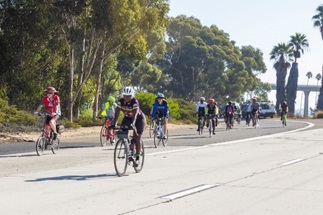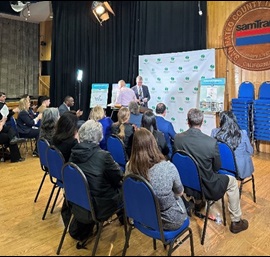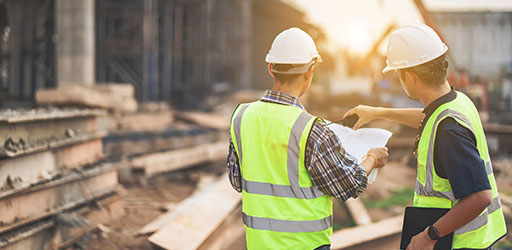Reconnecting Communities: Highways to Boulevards State Pilot Program
CONVERTING UNDERUTILIZED HIGHWAYS TO RESTORE COMMUNITY CONNECTIVITY

Freeway maintenance closure community event on 43rd connector on the I-805 in October 2024. Courtesy of Mana Ghodsian, Caltrans D11.

Site walk tour for RC:H2B program held on April 26, 2024. Courtesy of SMCTA.

District 1 walk audit with specialist Dan Burden in 2023 for RC:H2B program. Courtesy of Caltrans, D1.
In response to the adoption of Streets & Highways Code 104.3, the California Department of Transportation (Caltrans) is launching the Reconnecting Communities: Highways to Boulevards (RC:H2B) State Pilot Program. The program was established to plan for and fund the conversion of key underutilized highways in the State into multi-modal corridors to reconnect communities divided by transportation infrastructure. The historical harm will be addressed through community-based transportation planning, design, demolition, and/or reconstruction of city streets, parks, or other infrastructure.
Goals
- Restore community connectivity through the removal, retrofit, mitigation, or replacement of eligible transportation infrastructure facilities that create barriers to mobility, access, or economic development.
- Provide matching funding for potential federal grant funds.
- Advance health and equity outcomes for underserved communities by removing health, safety, and access barriers associated with transportation infrastructure within communities.
- Improve access to opportunity by improving travel options and reducing combined household transportation and housing costs for underserved communities.
- Create opportunities for implementation of affordable housing and furthering the advancement of fair housing.
- Prevent or minimize direct and indirect displacement effects from project implementation.
- Advance community-based or community-driven transportation planning.

RC:H2B Selected Communities
|
AGENCY NAME |
PROJECT TITLE |
CATEGORY |
PROJECT DESCRIPTION |
|
City of Arcata |
Reconnecting Arcata- The Arcata Cap |
Rural |
The Reconnecting Arcata Project seeks to address mobility and accessibility challenges caused by three state highways (US 101, SR 255, and SR 299) through comprehensive planning efforts. The project emphasizes meaningful input from partners and the public, leveraging existing local planning initiatives. Following a community driven process, key solutions may include a new transit center, potential freeway cap or new crossings, and enhancements to active transportation. The State Highway System is the most significant barrier to transportation in Arcata. It restricts Arcata residents' access to the Cal Poly Humboldt campus, and student housing neighborhoods, which is surrounded by low-income, Black, Indigenous and People of Color (BIPOC) communities. Bridging this gap would help lower health risks while providing more active transportation options. The proposal included opportunities to contribute to the preservation of existing biological corridors connecting the Arcata Community Forest, the Mad River, and Humboldt Bay and to help accelerate the building of affordable housing and mixed-use developments. |
|
San Diego Association of Governments (SANDAG) |
Reconnecting Southeastern San Diego and National City |
Corridor |
The Reconnecting Southeastern San Diego (SESD) and National City Project intends to holistically improve transportation options with the objective of reconnecting and reshaping land for the benefit of the community. After the construction of the Interstate 805 Corridor dating back to 1967, the communities of SESD and National City have been deeply affected by the history of redlining and dividing infrastructure. SANDAG has partnered with the City of San Diego, National City, Caltrans, and the community-based organizations Urban Collaborative Project, Groundworks San Diego-Chollas Creek, Mundo Gardens, to ensure this project fulfills the objectives and the vision of the surrounding communities. In alignment with the Promise Zone Initiative, this project intends to restore power to residents of SESD and National City and to identify priority projects that will best serve the needs and wants of the neighboring communities with facilities that may include bicycle and pedestrian connections, light rail enhancements, bus shelters, the creation of parks, and green and communal spaces. |
|
San Mateo County Transportation Authority (SMCTA) |
Connect 4 South San Francisco (Connect4SSF) |
Urban |
The Connect4SSF Project aims to improve connections between local neighborhoods in South San Francisco, such as Lindenville, Orange Park, Downtown South San Francisco, and the East Side. Historically, these communities have been divided from the rest of the city by infrastructure such as the US 101, El Camino Real, Colma Creek, and railroad tracks. These barriers, combined together, cause significant access issues for South San Francisco residents and workers. Connect4SSF seeks to remove or resolve these barrier impacts by improving access along and across priority corridors and by improving the areas around these barriers into desired destinations. The project will strengthen connections between transportation, housing, jobs, and parks and open spaces by establishing biking, pedestrian, transit, and open connections. |
RC:H2B Application Receipt Log
RC:H2B Program Milestones
The following is the projected timeline for the RC:H2B Program
| Draft Milestone Schedule | Date & Time |
|---|---|
| Call for Communities Application | June 20, 2023 |
| Application Deadline | September 20, 2023 5:00PM PDT |
| Selection Notification | March 12, 2024 8:30am PDT |
| Anticipated Start of Work |
July 2025 |
Stay Informed
For questions or more information on the RC:H2B State Pilot Program, please contact: CRCP@dot.ca.gov
Additional Information
- Caltrans Reconnecting Communities Program
- U.S. Department of Transportation Reconnecting Communities Pilot Grant Program
RC:H2B program is funded through California Climate Investments, a statewide initiative that puts billions of Cap-and-Trade dollars to work reducing greenhouse gas emissions, strengthening the economy, and improving public health and the environment — particularly in disadvantaged communities. California Climate Investments projects include affordable housing, renewable energy, public transportation, zero-emission vehicles, environmental restoration, more sustainable agriculture, recycling and much more. At least 35 percent of these investments are made in disadvantaged communities, low-income communities and households. For more information, please visit: California Climate Investments.







